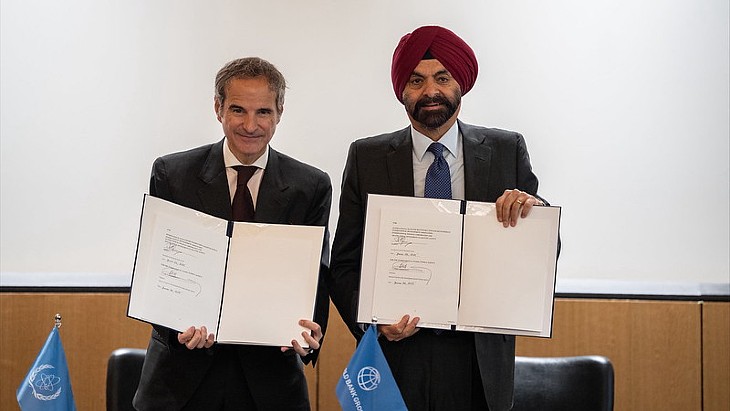Uranium resources adequate but investment needed
.jpg)
Uranium - Resources, Production and Demand, is the 27th edition of the biennial joint report by the OECD Nuclear Energy Agency (NEA) and the International Atomic Energy Agency (IAEA), providing the two organisations' most recent review of world uranium market fundamentals. Its statistical profile of the world uranium industry includes data from 41 uranium producing and consuming countries.
Total identified resources recoverable at a cost of up to USD130 per kilogram of uranium stood at 6,142,200 tU, as of 1 January 2017. This includes reasonably assured and inferred resources, and is an increase of 7.4% on the total reported in 2016. Some of these increases are due to new discoveries, but most are from re-evaluations of previously identified uranium resources, the report finds.
Global uranium mine production in 2016 was 62,071 tU - a 3% increase from 2015 - but has now started to decline, with 59,342 tU produced in 2017. Further reductions are expected in 2018 as major producing countries, including Canada and Kazakhstan, limit total production in response to the sustained low price of uranium, it says.
Uranium exploration and mine development expenditures declined from over USD2 billion in 2014 to USD663,678 million in 2016, and are expected to continue to decrease in response to a "sustained depressed uranium market", the report notes. Significant decreases were reported for Australia, Canada, China, the Czech Republic, Namibia, Russia and the USA. Kazahkstan reported an increase in expenditures from USD34.7 million to USD60.9 million from 2014 but this was followed by a sharp decline to USD23.9 million in 2016. Over 2016/17, Canada had the highest uranium and exploration development expenditures, followed by China and India.
"The decline in exploration and development expenditures for this reporting period reflects an adjustment within the industry in response to oversupply, which began with the depressed uranium market in the middle of 2011," the report says.
World nuclear net generating capacity was 391 GWe at the beginning of 2017, requiring 62,825 tU per year. By 2035, the report projects total net generating capacity to be between 331 GWe in its low demand case and 568 GWe net - an increase of 45% over today - in the high demand case, with world annual reactor-related uranium requirements (excluding mixed-oxide fuel) between 53,010 tU (low demand case) and 90,820 tU (high demand case).
2016 world uranium production of 62,071 tU provided about 99.9% of that year's world reactor requirements (62,285 tU). In 2017, global primary production provided about 95% of requirements, with the remainder supplied by so-called secondary sources, such as excess government and commercial inventories, used fuel reprocessing, underfeeding and uranium produced by the re-enrichment of depleted uranium tails, and low-enriched uranium produced by blending down highly enriched uranium. The availability of such secondary sources is generally expected to decline after 2018, the report says.
"The currently defined resource base is more than adequate to meet high case uranium demand through 2035, but doing so will depend upon timely investments to turn resources into refined uranium ready for nuclear fuel production," it notes. "Strong market conditions will be fundamental to attracting the required investment to the industry," the report says.
"In the wake of recent significant reductions in uranium production, the coming challenges are likely to be those associated with constrained investment capabilities, as a result of depressed market conditions that will push the industry to optimise its activities still further."
_49098.jpg)
_57190.jpg)
_70526.jpg)
_75453.jpg)





..._58412.jpg)

